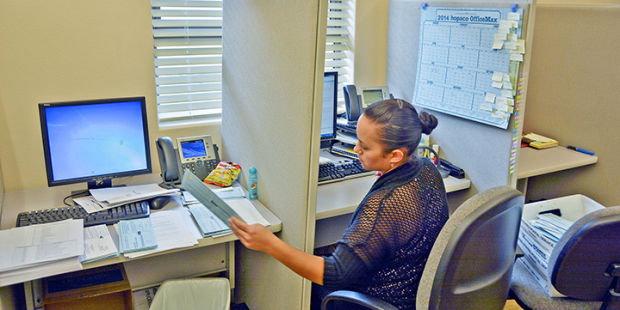LIHUE — It has been nearly three decades since Lilian de Mello made Kauai her home in the mid-1980s, but for most of those years, she was never able to vote. Though she was a permanent U.S. resident, de Mello
LIHUE — It has been nearly three decades since Lilian de Mello made Kauai her home in the mid-1980s, but for most of those years, she was never able to vote.
Though she was a permanent U.S. resident, de Mello was a green card holder, making her ineligible to vote in any election.
“I always wanted to vote,” de Mello said. “I’m originally from Uruguay and I was only able to vote one time in my life there. Since then, I’ve lived in many countries but never became a citizen.”
But that all changed last year, when the Kapaa resident officially became an American citizen.
So walking into the Historic County Annex Building on Monday and casting her vote in this year’s primary election was an exciting moment.
“It was very good to be able to do it,” de Mello said. “It was kind of emotional because I only voted one other time in my country of origin.”
Over the next two weeks, county voters will make their voices heard by either visiting one of the 16 designated polling locations to cast their ballots on Aug. 9 or sending in their absentee ballots through the mail.
Other voters, like de Mello, may also opt to vote in person — at the Historic County Annex Building — during the county’s early voting period.
But even after voters mark their ballots and turn them into elections officials and volunteers, all the work that happens behind the scenes has just begun.
“I guess the perception is, ‘Ah, go vote, go home, sit in front of the TV, crack open a beer and wait for the results,’ but there’s a lot that goes into allowing voters to just do that,” County Elections Administrator Lyndon Yoshioka said.
As of Monday, a total of 9,336 absentee ballots have been mailed out so far, according to county elections data. More than 40 percent of them, totaling 3,770 individual ballots, have been returned.
Absentee ballots that are returned, Yoshioka said, are initially separated by the island’s three individual districts before being into groups based on individual precincts — there are 16 on Kauai and Niihau.
“We do that to allow us to reconcile how many ballots we received,” Yoshioka explained. “When we receive the ballots, we are actually taking count of every ballot that comes in for a given district precinct.”
He estimates that about 200 to 300 mail-in absentee ballots a day have been arriving for the past week.
The signatures on every one of those ballots are also manually compared to a registered voter’s signature on file as a safeguard against voter fraud.
It is one that paid off last week when elections staff received two unsigned ballots that were allegedly stolen and fraudulently sent out. “What I’ve told my staff is that it’s unfortunate that it happened, but on another note, it proves that the process that we have in place works,” Yoshioka said.
After all of the absentee ballots are sorted and verified, they are stored away in county vaults until primary election day.
All told, about 41,210 people were registered to vote on Kauai as of Monday — a number that will slightly increase or decrease in the days leading up to the primary election as voter rolls are updated, Yoshioka said.
A total of 15,606 people, or 39.2 percent of the total number of registered voters in 2012, participated in that year’s primary election.
“What’s strange to me is how many people don’t even care to vote,” de Mello said. “I think that people should really engage themselves in the voting process, because if only half of the people participate, it’s not very representative of the island.”



